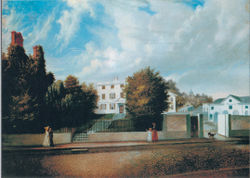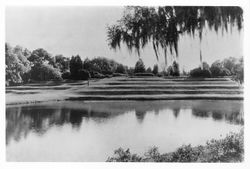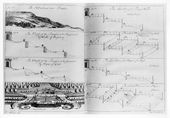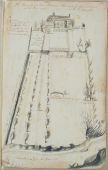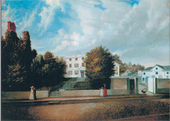Difference between revisions of "Fall/Falling garden"
(→Texts) |
A-whitlock (talk | contribs) |
||
| (22 intermediate revisions by 6 users not shown) | |||
| Line 5: | Line 5: | ||
[[File:1458.jpg|thumb|left|Fig. 1, Henry Cheever Pratt, ''The House of Gardiner Greene'', c. 1834.]] | [[File:1458.jpg|thumb|left|Fig. 1, Henry Cheever Pratt, ''The House of Gardiner Greene'', c. 1834.]] | ||
| − | + | [[File:1112.jpg|thumb|Fig. 2, [[Anthony St. John Baker]] (artist), B. King (lithograper), ''[[Riversdale]], near Bladensburg'', 1827.]] | |
| − | [[File:1112.jpg|thumb|Fig. 2, [[Anthony St. John Baker]] (artist), B. King (lithograper), ''Riversdale, near Bladensburg'', 1827.]] | ||
In 1789 Thomas Sheridan defined a fall as a “declivity” or “steep descent.” In American gardens, these inclines were commonly either [[slope]]s (located between [[terrace]]s) or flats, as at Mount Clare in Baltimore. A garden composed of a series of falls and [[terrace]]s was often called a falling garden. Level areas were generally connected by ramps or, more rarely, by stairs [Fig. 1]. In order to prevent erosion, steep falls had to be carefully constructed and either covered with turf or reinforced with masonry. The turfed fall seems to have been the predominant means of constructing a falling garden in America. Even so, evidence exists of gardens that had a single retaining [[wall]] between two levels, such as those at [[Riversdale]] in Maryland [Fig. 2], and examples of far more elaborate falling gardens with retaining [[wall]]s were illustrated by Michael van der Gucht [Fig. 3]. As a reference to a descent of water, “fall” is discussed in this study as a specialized water feature (see [[Cascade]]). | In 1789 Thomas Sheridan defined a fall as a “declivity” or “steep descent.” In American gardens, these inclines were commonly either [[slope]]s (located between [[terrace]]s) or flats, as at Mount Clare in Baltimore. A garden composed of a series of falls and [[terrace]]s was often called a falling garden. Level areas were generally connected by ramps or, more rarely, by stairs [Fig. 1]. In order to prevent erosion, steep falls had to be carefully constructed and either covered with turf or reinforced with masonry. The turfed fall seems to have been the predominant means of constructing a falling garden in America. Even so, evidence exists of gardens that had a single retaining [[wall]] between two levels, such as those at [[Riversdale]] in Maryland [Fig. 2], and examples of far more elaborate falling gardens with retaining [[wall]]s were illustrated by Michael van der Gucht [Fig. 3]. As a reference to a descent of water, “fall” is discussed in this study as a specialized water feature (see [[Cascade]]). | ||
| − | [[File:1042.jpg|thumb|left|Fig. 3, Michael van der Gucht, Illustration for chapter entitled: | + | [[File:1042.jpg|thumb|left|Fig. 3, Michael van der Gucht, Illustration for chapter entitled: “Of different [[terrace|Terrasses]] and Stairs, with their most exact Proportions,” in A.-J. Dézallier d’Argenville, ''The Theory and Practice of Gardening'' (1712), pl. opp. 117.]] |
| − | [[File:0632.jpg|thumb|Fig. 4, Anonymous, View of the | + | [[File:0632.jpg|thumb|Fig. 4, Anonymous, [[View]] of the [[terrace]]s at Middleton Place, in Alice B. Lockwood, ''Gardens of Colony and State'', 2 vols. (1934), 2:196.]] |
| − | The geographic distribution of falls appears to have been relatively localized, and the use of the term fairly short-lived. Citations that include the term “fall” or “falling garden” generally come from usage in the late | + | The geographic distribution of falls appears to have been relatively localized, and the use of the term fairly short-lived. Citations that include the term “fall” or “falling garden” generally come from usage in the late 18th and early 19th centuries in the mid-Atlantic/Chesapeake region. Examples range from Nazareth, Pennsylvania, to the north, to Williamsburg, Virginia, to the south. Extant sites, such as Middleton Place, near Charleston [Fig. 4], suggest the falling garden’s wider geographic distribution. Yet, when utilized in written accounts, the term appears to have had more limited usage. The related term “[[slope]]” appears to have been used more broadly, with examples ranging from New England to Georgia and was applied to longer, gradual descents, including natural hillsides, the sides of mounds, and raised [[terrace]] [[walk]]s.<ref>The term “slope,” like “fall,” described a declivity. In landscape design vocabulary it was used to refer to both a gradual descent and a steep grade, such as that on a mount or between terraces, as in the plan for a Garden Olitory at Jefferson’s Monticello.</ref> |
| − | Citations suggest that treatise writers, with the exception of Thomas Whately (1770), usually used the term “[[slope]]” rather than “fall” in general discussions of rising and falling ground. By contrast, the term “fall” was used more specifically to describe the descents between level areas of a [[terrace]]d garden. For example, George Washington used “[[slope]]” and “fall” interchangeably to describe the same feature in his kitchen garden, but “fall” was used to describe the short descent between a series of [[terrace]]s that formed a falling garden. | + | Citations suggest that treatise writers, with the exception of Thomas Whately (1770), usually used the term “[[slope]]” rather than “fall” in general discussions of rising and falling ground. By contrast, the term “fall” was used more specifically to describe the descents between level areas of a [[terrace]]d garden. For example, George Washington used “[[slope]]” and “fall” interchangeably to describe the same feature in his [[kitchen garden]], but “fall” was used to describe the short descent between a series of [[terrace]]s that formed a falling garden. |
| − | The concentration of falling gardens in the Chesapeake watershed area may have been due, in part, to their appropriateness to the estuarial topography in the region. Houses commonly were sited upon more protected, elevated knolls, or along the banks of many rivers and streams that fed the Chesapeake (see [[Eminence]], [[Prospect]], and [[View]]). Terracing these natural hillsides not only created level ground for planting [[bed]]s or [[parterre]]s but also enhanced [[view]]s to and from the house. For instance, when looking out from the top of the garden, each [[terrace]] below was not fully visible because of the drop in elevation. The effect was a foreshortened [[view]], often creating the impression, as Mary M. Ambler noted in 1770, that the garden at Mount Clare incorporated the broader landscape. By varying the widths of the [[terrace]]s, garden designers created the illusion of a greater or lesser distance than what actually existed. For instance, by making the [[terrace]]s near the house wider, as at the garden of William Paca in Annapolis, | + | The concentration of falling gardens in the Chesapeake watershed area may have been due, in part, to their appropriateness to the estuarial topography in the region. Houses commonly were sited upon more protected, elevated knolls, or along the banks of many rivers and streams that fed the Chesapeake (see [[Eminence]], [[Prospect]], and [[View]]). Terracing these natural hillsides not only created level ground for planting [[bed]]s or [[parterre]]s but also enhanced [[view]]s to and from the house. For instance, when looking out from the top of the garden, each [[terrace]] below was not fully visible because of the drop in elevation. The effect was a foreshortened [[view]], often creating the impression, as Mary M. Ambler noted in 1770, that the garden at Mount Clare incorporated the broader landscape. By varying the widths of the [[terrace]]s, garden designers created the illusion of a greater or lesser distance than what actually existed. For instance, by making the [[terrace]]s near the house wider, as at the garden of William Paca in Annapolis, Maryland, the [[view]] from the top [[terrace]] to the [[summerhouse]] appeared more distant than it was, thus elongating the limited space of its urban lot. Research has highlighted the geometrically complex work of anonymous falling garden designers who often based the dimensions of [[terrace]]s and [[slope]]s on measurements of the dwelling house.<ref>Barbara Paca-Steele, with St. Clair Wright, “The Mathematics of an Eighteenth-Century Wilderness Garden,” ''Journal of Garden History'' 6 (October–December 1986): 299–320, [https://www.zotero.org/groups/54737/items/itemKey/BXR4J256 view on Zotero]; Mark P. Leone and Paul A. Shackel, “Plane and Solid Geometry in Colonial Gardens in Annapolis, Maryland,” in ''Earth Patterns: Archaeology of Early American and Ancient Landscapes'', ed. William Kelso and Rachel M. Most (Charlottesville: University of Virginia Press, 1990), 153–67, [https://www.zotero.org/groups/54737/items/itemKey/W7VHDPT7 view on Zotero].</ref> |
[[File:0505.jpg|thumb|Fig. 5, Anonymous (artist), Benjamin Tanner (engraver), ''University of Virginia'', 1826.]] | [[File:0505.jpg|thumb|Fig. 5, Anonymous (artist), Benjamin Tanner (engraver), ''University of Virginia'', 1826.]] | ||
| + | Recent scholarship about the Chesapeake landscape argues that the series of [[terrace]]s connected by grass ramps or stairs (much like the series of rooms and halls in a dwelling), created a sequence of social barriers through which one navigated, with the final destination determined by one’s social status.<ref>Dell Upton, “White and Black Landscapes in Eighteenth-Century Virginia,” in ''Material Culture in America, 1600–1860'', ed. Robert Blair St. George (Boston: Northeastern University Press, 1988), 357–69, [https://www.zotero.org/groups/54737/items/itemKey/N9BT889P view on Zotero]; Elizabeth Kryder-Reid, “The Archaeology of Vision in Eighteenth-Century Chesapeake Gardens,” ''Journal of Garden History'' 14 (spring 1994): 42–54, [https://www.zotero.org/groups/54737/items/itemKey/IJX4M93V view on Zotero].</ref> Without using the term “falling garden,” John Adams succinctly described in 1777 the effect of the impressive sequence of plateaus as he walked through the “splendid [[seat]]” of a barrister, Mr. Carroll, at Mount Clare: “It is a large and elegant house; it stands fronting looking down the river into the harbor; it is one mile from the water; there is a descent not far from the house;— you have a fine garden; then you descend a few steps and have another fine garden; you go down a few more and have another.”<ref>Charles Francis Adams, ed., ''The Works of John Adams'' (Boston: Charles C. Little and James Brown, 1850), 435, [https://www.zotero.org/groups/54737/items/itemKey/WT73AURT view on Zotero].</ref> | ||
| − | + | In addition to their popularity among planter gentry, falls or [[slope]]s were also incorporated in campus landscape designs, as in the plan of Union College in Schenectady, New York, by Joseph Jacques Ramée, and of the University of Virginia, designed by [[Thomas Jefferson]] [Fig. 5]. In these settings, the declivity created a separation of space, as in the formation of the series of forecourts in the Ramée plan, without imposing visual barriers. In the case of Union College, the visual effect was enhanced by its “telescopic shape, with spaces that progressively narrowed as they mounted the hill, heightening the sense of perspective depth.”<ref>Paul V. Turner, ''Joseph Ramée: International Architect of the Revolutionary Era'' (Cambridge: Cambridge University Press, 1996), 201, [https://www.zotero.org/groups/54737/items/itemKey/667JZS6S view on Zotero].</ref> | |
| − | + | —''Elizabeth Kryder-Reid'' | |
| − | + | <hr> | |
==Texts== | ==Texts== | ||
| − | |||
===Usage=== | ===Usage=== | ||
| + | [[File:0187.jpg|thumb|right|Fig. 6, Charles Willson Peale, Mount Clare, south façade and garden, 1775.]] | ||
| − | [[ | + | * Ambler, Mary M., 1770, describing Mount Clare, [[plantation]] of Charles and Margaret Tilgham Carroll, Baltimore, MD (quoted in Sarudy 1989: 138–39)<ref name="Sarudy">Barbara Wells Sarudy, “Eighteenth-Century Gardens of the Chesapeake,” ''Journal of Garden History'' 9 (1989): 104–59, [https://www.zotero.org/groups/54737/items/itemKey/PGSNXHMJ view on Zotero].</ref> |
| − | + | : “About two miles from Baltimore There is an exceeding handsome [[Seat]] called Mount Clare belonging to Mr. Charles Carrel of Annapolis Son of Dr. Carrel. . . took a great deal of Pleasure in looking at the [[bowling Green]] & also at the Garden which is a very large '''Falling Garden'''. . . You step out of the Door into the [[Bowling_green|Bowlg Green]] from which the Garden '''Falls''' & when You stand on the Top of it there is such a Uniformity of Each side as the whole [[plantation|Plantn]] seems to be laid out like a Garden.” [Fig. 6] | |
| − | |||
| + | * Carroll, Charles (of Annapolis), 1772, in a letter to Charles Carroll (of Carrollton), describing the Carroll Garden, Annapolis, MD (Maryland Historical Society, A. E. Carroll Papers) | ||
| − | + | : “If you wish to make a continental [[slope]] from ye [[Gate]] to ye wash house, I apprehend the Quantity of Water in great Rains going yt way may prove inconvenient. I think you should make as much of yt Road as you can with a '''fall''' to the street.” | |
| − | |||
| + | * Anonymous, May 2, 1777, describing in the ''Virginia Gazette'' a property for sale in Fredericksburg, VA (Colonial Williamsburg Foundation) | ||
| − | + | : “For sale, eight valuable lots in the town of Fredericksburg. . . Four of those lots are well improved with a good '''falling garden'''.” | |
| − | |||
| + | * Shippen, Thomas Lee, 1783, describing Westover, [[seat]] of William Byrd III, on the James River, VA (quoted in Lounsbury 1994: 135)<ref name="Lounsbury">Carl R. Lounsbury, ed., ''An Illustrated Glossary of Early Southern Architecture and Landscape'' (New York: Oxford University Press, 1994), [https://www.zotero.org/groups/54737/items/itemKey/UK5TCUQQ view on Zotero].</ref> | ||
| − | + | : “[At Westover, there was] a view of a prettily '''falling''' grass [[plat]]. . . about 300 by 100 yards in extent an extensive prospect of James River and of all the Country and some Gentlemen’s [[seat]]s on the other side.” | |
| − | |||
| + | *Washington, George, February 12, 1785, describing [[Mount Vernon]], [[plantation]] of George Washington, Fairfax County, VA (Jackson and Twohig, eds., 1978: 4:89)<ref>George Washington, ''The Diaries of George Washington'', ed. Donald Jackson and Dorothy Twohig, 6 vols. (Charlottesville: University Press of Virginia, 1978), [https://www.zotero.org/groups/54737/items/itemKey/9ZIIR3FT view on Zotero].</ref> | ||
| − | + | : “Planted Eight young Pair Trees sent me by Doctr. Craik in the following places. . . | |
| + | : “3 Brown Beuries in the west [[square]] in the Second flat—viz. 1 on the [[border]] (middle thereof) next the '''Fall''' or [[slope]]—the other two on the border above the walk next the old Stone Wall.” | ||
| − | |||
| − | |||
| + | * Anonymous, April 22, 1794, describing in the ''Baltimore Daily Intelligencer'' the garden of John Salmon, Baltimore, MD (quoted in Sarudy 1989: 130)<ref name="Sarudy"></ref> | ||
| − | + | : “The garden ground, which is in fine order, is laid off in beautiful '''falls''': in it is an excellent cold bath and a milk house through which there runs a constant stream of water.” | |
| − | |||
| + | * Ogden, John Cosens, 1799, describing a garden in Nazareth, PA (1800: 46)<ref>John C. Ogden, ''An Excursion into Bethlehem & Nazareth, in Pennsylvania, in the Year 1799'' (Philadelphia: Charles Cist, 1800), [https://www.zotero.org/groups/54737/items/itemKey/U5CTTBGB view on Zotero].</ref> | ||
| − | + | : “The strait and circular [[walk]]s, the windings up the hill, the '''falling gardens''' ascended by steps, the banks, [[Summerhouse|summer-houses]], [[seat]]s, trees, herbs, fruits, vegetables and flowers are seen in great variety. | |
| + | : “Most of the American forest trees and many exotic plants are here. It is an elegant garden in miniature.” | ||
| − | |||
| − | |||
| + | * Anonymous, January 24, 1800, describing in the ''Virginia Herald'' a property for sale in Madison County, VA (Colonial Williamsburg Foundation) | ||
| − | + | : “Haphazard Mills and Farm for sale. . . The improvements on the farm are a new dwelling house. . . and an unfinished '''falling garden''', with several springs of good water near the house.” | |
| − | |||
| + | * Anonymous, 1805, describing in the ''Virginia Argus'' a construction project in Richmond, VA (quoted in Lounsbury 1994: 26)<ref name="Lounsbury"></ref> | ||
| − | + | : “ERECTED A [[Bathhouse|BATHING HOUSE]] At the '''Falling Garden''', CONTAINING four rooms: each has a Bath, and supplied with Hot and Cold Water.” | |
| − | |||
| + | * [[Peale, Charles Willson]], October 13, 1816, describing [[Belfield]], estate of [[Charles Willson Peale]], Germantown, PA (Miller et al., eds., 1991: 3:452)<ref>Lillian B. Miller et al., eds., ''The Selected Papers of Charles Willson Peale and His Family'', vol. 3, ''The Belfield Farm Years, 1810–1820'' (New Haven, CT: Yale University Press, 1991), [https://www.zotero.org/groups/54737/items/itemKey/IZAKPCBG view on Zotero].</ref> | ||
| − | + | : “Other parts of my farm excited the curiousity of the Public—a wind-mill for pumping Water for the Cattle &c.—A '''falling Garden''', [[fountain]], fish [[Pond]], common Sewers &c Machines to add [aid] the dairy and carriages of various uses—all these things employed the whole of my time to emprove & to keep them in proper order.” | |
| − | |||
| + | * Anonymous, December 24, 1817, describing in the ''Virginia Herald'' a property for sale in Culpeper County, VA (Colonial Williamsburg Foundation) | ||
| − | + | : “For sale. . . the mansion house tract. . . The grounds well laid off about the house, with a beautiful and productive '''falling garden'''.” | |
| − | |||
| + | * Watson, John Fanning, 1857, describing the garden of Israel Pemberton, Philadelphia, PA (1857: 1:375)<ref>John Fanning Watson, ''Annals of Philadelphia and Pennsylvania in the Olden Time. . . '', 2 vols. (Philadelphia: E. Thomas, 1857), [https://www.zotero.org/groups/54737/items/itemKey/5PTKBUW2 view on Zotero].</ref> | ||
| − | + | : “The garden itself being upon an inclined plane, had three or four '''falls''' or platforms.” | |
| − | |||
===Citations=== | ===Citations=== | ||
| − | * Whately, Thomas, 1770, ''Observations on Modern Gardening'' ( | + | * Whately, Thomas, 1770, ''Observations on Modern Gardening'' (1770; repr., 1982: 17, 25)<ref>Thomas Whately, ''Observations on Modern Gardening'', 3rd ed. (1770; repr., London: Garland, 1982), [https://www.zotero.org/groups/54737/items/itemKey/QKRK8DCD view on Zotero].</ref> |
: “If a steep descends in a succession of abrupt '''falls''', nearly equal, they have the appearance of steps, and are neither pleasing nor wild; but if they are made to differ in height and length, the objection is removed: . . . | : “If a steep descends in a succession of abrupt '''falls''', nearly equal, they have the appearance of steps, and are neither pleasing nor wild; but if they are made to differ in height and length, the objection is removed: . . . | ||
| − | : | + | : “. . . if a line of trees run close upon the [[Edging|edge]] of an abrupt '''fall''', they give it depth and importance. By such means a [[view]] may be improved.” |
| − | * Sheridan, Thomas, 1789, ''A Complete Dictionary of the English Language'' (n.p.) <ref>Thomas A. Sheridan, ''A Complete Dictionary of the English Language | + | * Sheridan, Thomas, 1789, ''A Complete Dictionary of the English Language'' (1789: n.p.)<ref>Thomas A. Sheridan, ''A Complete Dictionary of the English Language. . . ,'' 5th ed. (Philadelphia: William Young, 1789), [https://www.zotero.org/groups/54737/items/itemKey/T5GU4CBQ view on Zotero].</ref> |
| − | : “'''FALL''', fa’l. s | + | : “'''FALL''', fa’l. s. . . declivity, steep descent; [[cataract]], [[cascade]]; the outlet of a current into any other water.” |
| + | |||
| + | <hr> | ||
==Images== | ==Images== | ||
| − | |||
===Inscribed=== | ===Inscribed=== | ||
| Line 116: | Line 116: | ||
File:1849.jpg|[[Charles Willson Peale]], ''Lower falls of Schuylkill, 5 miles from Philadelphia'', c. 1770. | File:1849.jpg|[[Charles Willson Peale]], ''Lower falls of Schuylkill, 5 miles from Philadelphia'', c. 1770. | ||
| − | File:0331.jpg| | + | File:0331.jpg|George Washington, ''Drawing and Notes for a [[Ha-Ha]] Wall at [[Mount Vernon]], October 1798'', 1798. |
| − | |||
</gallery> | </gallery> | ||
| Line 124: | Line 123: | ||
<gallery widths="170px" heights="170px" perrow="7"> | <gallery widths="170px" heights="170px" perrow="7"> | ||
| − | File:0187.jpg| | + | File:0187.jpg|[[Charles Willson Peale]], [[Mount]] Clare, south façade and garden, 1775. |
| − | |||
</gallery> | </gallery> | ||
| Line 132: | Line 130: | ||
<gallery widths="170px" heights="170px" perrow="7"> | <gallery widths="170px" heights="170px" perrow="7"> | ||
| − | File:1042.jpg|Michael van der Gucht, Illustration for chapter entitled: | + | File:1042.jpg|Michael van der Gucht, Illustration for chapter entitled: “Of different [[terrace|Terrasses]] and Stairs, with their most exact Proportions,” in A.-J. Dézallier d’Argenville, ''The Theory and Practice of Gardening'' (1712), pl. opp. 117. |
| − | File:0056.jpg|[[John Bartram|John]] or [[William Bartram]], | + | File:0056.jpg|[[John Bartram|John]] or [[William Bartram]], "A Draught of [[Bartram_Botanic_Garden_and_Nursery|John Bartram’s House and Garden]] as it appears from the River", 1758. |
| − | File: | + | File:0207_detail.jpg|Francis Guy, ''Mt. Deposit'' [detail], 1803-05. |
| − | File:0124.jpg|Jane Shearer, Brick House with | + | File:0207.jpg|Francis Guy, ''Mt. Deposit'', 1803–5. |
| + | |||
| + | File:0124.jpg|Jane Shearer, Brick House with [[Terrace]]s, 1806, in Sotheby’s New York, ''Important American Schoolgirl Embroideries'' (January 2012): 80.<ref>Sotheby’s New York, ''Important American Schoolgirl Embroideries'' (January 2012), [https://www.zotero.org/groups/54737/keywords_in_early_american_landscape_design/items/itemKey/I9SQRZDH view on Zotero].</ref> | ||
File:0102.jpg|Joseph Jacques Ramée, Plan of the Campus Grounds, Union College, 1813. | File:0102.jpg|Joseph Jacques Ramée, Plan of the Campus Grounds, Union College, 1813. | ||
| − | File:0514.jpg|Catherine Mary Wheeler, Sampler, 1825. | + | File:0514.jpg|Catherine Mary Wheeler, Sampler, 1825. |
File:0505.jpg|Anonymous (artist), Benjamin Tanner (engraver), ''University of Virginia'', 1826. | File:0505.jpg|Anonymous (artist), Benjamin Tanner (engraver), ''University of Virginia'', 1826. | ||
| − | File:1112.jpg|[[Anthony St. John Baker]] (artist), B. King (lithograper), ''Riversdale, near Bladensburg'', 1827. | + | File:1112.jpg|[[Anthony St. John Baker]] (artist), B. King (lithograper), ''[[Riversdale]], near Bladensburg'', 1827. |
File:1458.jpg|Henry Cheever Pratt, ''The House of Gardiner Greene'', c. 1834. | File:1458.jpg|Henry Cheever Pratt, ''The House of Gardiner Greene'', c. 1834. | ||
| − | File:0632.jpg|Anonymous, View of the | + | File:0632.jpg|Anonymous, [[View]] of the [[terrace]]s at Middleton Place, in Alice B. Lockwood, ''Gardens of Colony and State'', 2 vols. (1934), 2:196. |
| + | </gallery> | ||
| − | < | + | <hr> |
==Notes== | ==Notes== | ||
Latest revision as of 19:45, August 10, 2021
(Fall garden)
See also: Terrace
History
In 1789 Thomas Sheridan defined a fall as a “declivity” or “steep descent.” In American gardens, these inclines were commonly either slopes (located between terraces) or flats, as at Mount Clare in Baltimore. A garden composed of a series of falls and terraces was often called a falling garden. Level areas were generally connected by ramps or, more rarely, by stairs [Fig. 1]. In order to prevent erosion, steep falls had to be carefully constructed and either covered with turf or reinforced with masonry. The turfed fall seems to have been the predominant means of constructing a falling garden in America. Even so, evidence exists of gardens that had a single retaining wall between two levels, such as those at Riversdale in Maryland [Fig. 2], and examples of far more elaborate falling gardens with retaining walls were illustrated by Michael van der Gucht [Fig. 3]. As a reference to a descent of water, “fall” is discussed in this study as a specialized water feature (see Cascade).
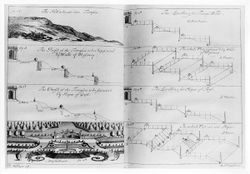
The geographic distribution of falls appears to have been relatively localized, and the use of the term fairly short-lived. Citations that include the term “fall” or “falling garden” generally come from usage in the late 18th and early 19th centuries in the mid-Atlantic/Chesapeake region. Examples range from Nazareth, Pennsylvania, to the north, to Williamsburg, Virginia, to the south. Extant sites, such as Middleton Place, near Charleston [Fig. 4], suggest the falling garden’s wider geographic distribution. Yet, when utilized in written accounts, the term appears to have had more limited usage. The related term “slope” appears to have been used more broadly, with examples ranging from New England to Georgia and was applied to longer, gradual descents, including natural hillsides, the sides of mounds, and raised terrace walks.[1]
Citations suggest that treatise writers, with the exception of Thomas Whately (1770), usually used the term “slope” rather than “fall” in general discussions of rising and falling ground. By contrast, the term “fall” was used more specifically to describe the descents between level areas of a terraced garden. For example, George Washington used “slope” and “fall” interchangeably to describe the same feature in his kitchen garden, but “fall” was used to describe the short descent between a series of terraces that formed a falling garden.
The concentration of falling gardens in the Chesapeake watershed area may have been due, in part, to their appropriateness to the estuarial topography in the region. Houses commonly were sited upon more protected, elevated knolls, or along the banks of many rivers and streams that fed the Chesapeake (see Eminence, Prospect, and View). Terracing these natural hillsides not only created level ground for planting beds or parterres but also enhanced views to and from the house. For instance, when looking out from the top of the garden, each terrace below was not fully visible because of the drop in elevation. The effect was a foreshortened view, often creating the impression, as Mary M. Ambler noted in 1770, that the garden at Mount Clare incorporated the broader landscape. By varying the widths of the terraces, garden designers created the illusion of a greater or lesser distance than what actually existed. For instance, by making the terraces near the house wider, as at the garden of William Paca in Annapolis, Maryland, the view from the top terrace to the summerhouse appeared more distant than it was, thus elongating the limited space of its urban lot. Research has highlighted the geometrically complex work of anonymous falling garden designers who often based the dimensions of terraces and slopes on measurements of the dwelling house.[2]
Recent scholarship about the Chesapeake landscape argues that the series of terraces connected by grass ramps or stairs (much like the series of rooms and halls in a dwelling), created a sequence of social barriers through which one navigated, with the final destination determined by one’s social status.[3] Without using the term “falling garden,” John Adams succinctly described in 1777 the effect of the impressive sequence of plateaus as he walked through the “splendid seat” of a barrister, Mr. Carroll, at Mount Clare: “It is a large and elegant house; it stands fronting looking down the river into the harbor; it is one mile from the water; there is a descent not far from the house;— you have a fine garden; then you descend a few steps and have another fine garden; you go down a few more and have another.”[4]
In addition to their popularity among planter gentry, falls or slopes were also incorporated in campus landscape designs, as in the plan of Union College in Schenectady, New York, by Joseph Jacques Ramée, and of the University of Virginia, designed by Thomas Jefferson [Fig. 5]. In these settings, the declivity created a separation of space, as in the formation of the series of forecourts in the Ramée plan, without imposing visual barriers. In the case of Union College, the visual effect was enhanced by its “telescopic shape, with spaces that progressively narrowed as they mounted the hill, heightening the sense of perspective depth.”[5]
—Elizabeth Kryder-Reid
Texts
Usage
- Ambler, Mary M., 1770, describing Mount Clare, plantation of Charles and Margaret Tilgham Carroll, Baltimore, MD (quoted in Sarudy 1989: 138–39)[6]
- “About two miles from Baltimore There is an exceeding handsome Seat called Mount Clare belonging to Mr. Charles Carrel of Annapolis Son of Dr. Carrel. . . took a great deal of Pleasure in looking at the bowling Green & also at the Garden which is a very large Falling Garden. . . You step out of the Door into the Bowlg Green from which the Garden Falls & when You stand on the Top of it there is such a Uniformity of Each side as the whole Plantn seems to be laid out like a Garden.” [Fig. 6]
- Carroll, Charles (of Annapolis), 1772, in a letter to Charles Carroll (of Carrollton), describing the Carroll Garden, Annapolis, MD (Maryland Historical Society, A. E. Carroll Papers)
- “If you wish to make a continental slope from ye Gate to ye wash house, I apprehend the Quantity of Water in great Rains going yt way may prove inconvenient. I think you should make as much of yt Road as you can with a fall to the street.”
- Anonymous, May 2, 1777, describing in the Virginia Gazette a property for sale in Fredericksburg, VA (Colonial Williamsburg Foundation)
- “For sale, eight valuable lots in the town of Fredericksburg. . . Four of those lots are well improved with a good falling garden.”
- Shippen, Thomas Lee, 1783, describing Westover, seat of William Byrd III, on the James River, VA (quoted in Lounsbury 1994: 135)[7]
- “[At Westover, there was] a view of a prettily falling grass plat. . . about 300 by 100 yards in extent an extensive prospect of James River and of all the Country and some Gentlemen’s seats on the other side.”
- Washington, George, February 12, 1785, describing Mount Vernon, plantation of George Washington, Fairfax County, VA (Jackson and Twohig, eds., 1978: 4:89)[8]
- “Planted Eight young Pair Trees sent me by Doctr. Craik in the following places. . .
- “3 Brown Beuries in the west square in the Second flat—viz. 1 on the border (middle thereof) next the Fall or slope—the other two on the border above the walk next the old Stone Wall.”
- Anonymous, April 22, 1794, describing in the Baltimore Daily Intelligencer the garden of John Salmon, Baltimore, MD (quoted in Sarudy 1989: 130)[6]
- “The garden ground, which is in fine order, is laid off in beautiful falls: in it is an excellent cold bath and a milk house through which there runs a constant stream of water.”
- Ogden, John Cosens, 1799, describing a garden in Nazareth, PA (1800: 46)[9]
- “The strait and circular walks, the windings up the hill, the falling gardens ascended by steps, the banks, summer-houses, seats, trees, herbs, fruits, vegetables and flowers are seen in great variety.
- “Most of the American forest trees and many exotic plants are here. It is an elegant garden in miniature.”
- Anonymous, January 24, 1800, describing in the Virginia Herald a property for sale in Madison County, VA (Colonial Williamsburg Foundation)
- “Haphazard Mills and Farm for sale. . . The improvements on the farm are a new dwelling house. . . and an unfinished falling garden, with several springs of good water near the house.”
- Anonymous, 1805, describing in the Virginia Argus a construction project in Richmond, VA (quoted in Lounsbury 1994: 26)[7]
- “ERECTED A BATHING HOUSE At the Falling Garden, CONTAINING four rooms: each has a Bath, and supplied with Hot and Cold Water.”
- Peale, Charles Willson, October 13, 1816, describing Belfield, estate of Charles Willson Peale, Germantown, PA (Miller et al., eds., 1991: 3:452)[10]
- “Other parts of my farm excited the curiousity of the Public—a wind-mill for pumping Water for the Cattle &c.—A falling Garden, fountain, fish Pond, common Sewers &c Machines to add [aid] the dairy and carriages of various uses—all these things employed the whole of my time to emprove & to keep them in proper order.”
- Anonymous, December 24, 1817, describing in the Virginia Herald a property for sale in Culpeper County, VA (Colonial Williamsburg Foundation)
- “For sale. . . the mansion house tract. . . The grounds well laid off about the house, with a beautiful and productive falling garden.”
- Watson, John Fanning, 1857, describing the garden of Israel Pemberton, Philadelphia, PA (1857: 1:375)[11]
- “The garden itself being upon an inclined plane, had three or four falls or platforms.”
Citations
- Whately, Thomas, 1770, Observations on Modern Gardening (1770; repr., 1982: 17, 25)[12]
- “If a steep descends in a succession of abrupt falls, nearly equal, they have the appearance of steps, and are neither pleasing nor wild; but if they are made to differ in height and length, the objection is removed: . . .
- “. . . if a line of trees run close upon the edge of an abrupt fall, they give it depth and importance. By such means a view may be improved.”
- Sheridan, Thomas, 1789, A Complete Dictionary of the English Language (1789: n.p.)[13]
- “FALL, fa’l. s. . . declivity, steep descent; cataract, cascade; the outlet of a current into any other water.”
Images
Inscribed
Charles Willson Peale, Lower falls of Schuylkill, 5 miles from Philadelphia, c. 1770.
George Washington, Drawing and Notes for a Ha-Ha Wall at Mount Vernon, October 1798, 1798.
Associated
Charles Willson Peale, Mount Clare, south façade and garden, 1775.
Attributed
Michael van der Gucht, Illustration for chapter entitled: “Of different Terrasses and Stairs, with their most exact Proportions,” in A.-J. Dézallier d’Argenville, The Theory and Practice of Gardening (1712), pl. opp. 117.
John or William Bartram, "A Draught of John Bartram’s House and Garden as it appears from the River", 1758.
Anthony St. John Baker (artist), B. King (lithograper), Riversdale, near Bladensburg, 1827.
Notes
- ↑ The term “slope,” like “fall,” described a declivity. In landscape design vocabulary it was used to refer to both a gradual descent and a steep grade, such as that on a mount or between terraces, as in the plan for a Garden Olitory at Jefferson’s Monticello.
- ↑ Barbara Paca-Steele, with St. Clair Wright, “The Mathematics of an Eighteenth-Century Wilderness Garden,” Journal of Garden History 6 (October–December 1986): 299–320, view on Zotero; Mark P. Leone and Paul A. Shackel, “Plane and Solid Geometry in Colonial Gardens in Annapolis, Maryland,” in Earth Patterns: Archaeology of Early American and Ancient Landscapes, ed. William Kelso and Rachel M. Most (Charlottesville: University of Virginia Press, 1990), 153–67, view on Zotero.
- ↑ Dell Upton, “White and Black Landscapes in Eighteenth-Century Virginia,” in Material Culture in America, 1600–1860, ed. Robert Blair St. George (Boston: Northeastern University Press, 1988), 357–69, view on Zotero; Elizabeth Kryder-Reid, “The Archaeology of Vision in Eighteenth-Century Chesapeake Gardens,” Journal of Garden History 14 (spring 1994): 42–54, view on Zotero.
- ↑ Charles Francis Adams, ed., The Works of John Adams (Boston: Charles C. Little and James Brown, 1850), 435, view on Zotero.
- ↑ Paul V. Turner, Joseph Ramée: International Architect of the Revolutionary Era (Cambridge: Cambridge University Press, 1996), 201, view on Zotero.
- ↑ 6.0 6.1 Barbara Wells Sarudy, “Eighteenth-Century Gardens of the Chesapeake,” Journal of Garden History 9 (1989): 104–59, view on Zotero.
- ↑ 7.0 7.1 Carl R. Lounsbury, ed., An Illustrated Glossary of Early Southern Architecture and Landscape (New York: Oxford University Press, 1994), view on Zotero.
- ↑ George Washington, The Diaries of George Washington, ed. Donald Jackson and Dorothy Twohig, 6 vols. (Charlottesville: University Press of Virginia, 1978), view on Zotero.
- ↑ John C. Ogden, An Excursion into Bethlehem & Nazareth, in Pennsylvania, in the Year 1799 (Philadelphia: Charles Cist, 1800), view on Zotero.
- ↑ Lillian B. Miller et al., eds., The Selected Papers of Charles Willson Peale and His Family, vol. 3, The Belfield Farm Years, 1810–1820 (New Haven, CT: Yale University Press, 1991), view on Zotero.
- ↑ John Fanning Watson, Annals of Philadelphia and Pennsylvania in the Olden Time. . . , 2 vols. (Philadelphia: E. Thomas, 1857), view on Zotero.
- ↑ Thomas Whately, Observations on Modern Gardening, 3rd ed. (1770; repr., London: Garland, 1982), view on Zotero.
- ↑ Thomas A. Sheridan, A Complete Dictionary of the English Language. . . , 5th ed. (Philadelphia: William Young, 1789), view on Zotero.
- ↑ Sotheby’s New York, Important American Schoolgirl Embroideries (January 2012), view on Zotero.
